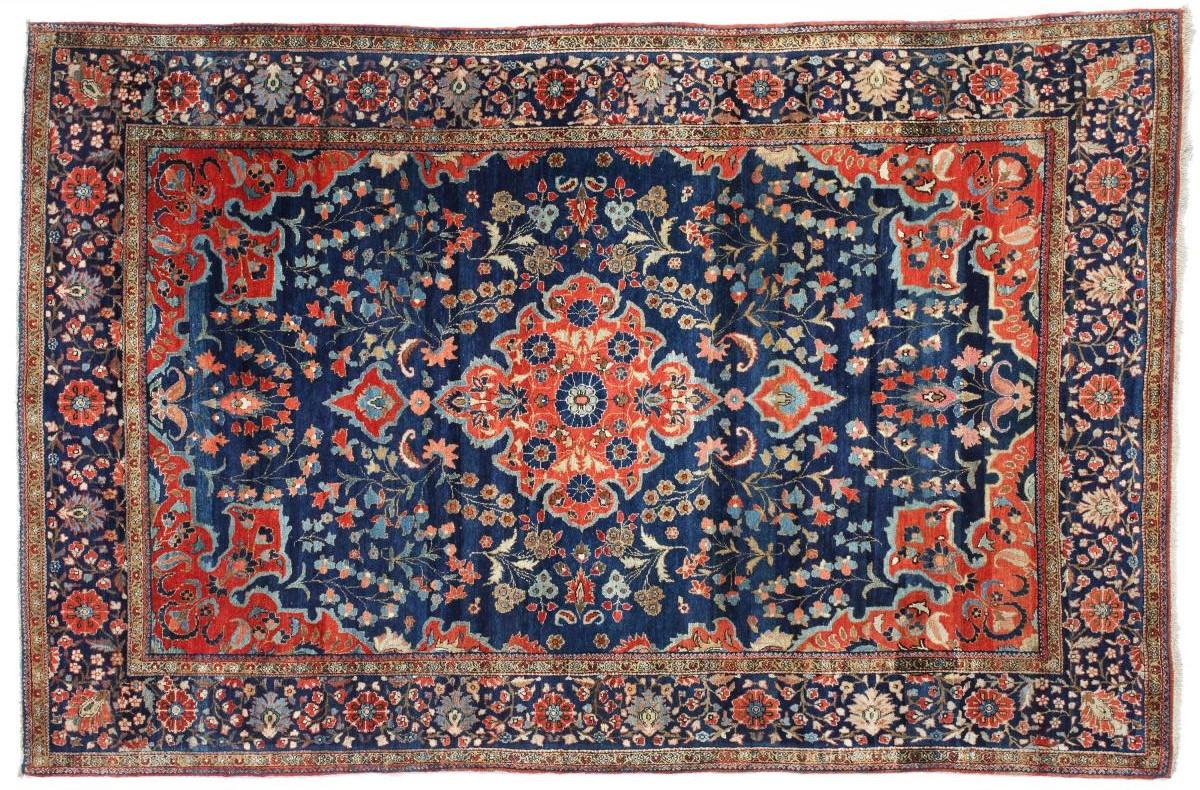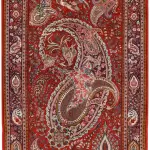What are the characteristics of Kashan handmade carpet?
The city of Kashan is located 258 km from Tehran and is considered one of the most historical areas in the Iranian plateau. The results of archeological findings show that Silk Hill, which is located 4 kilometers west of Kashan, is one of the first centers of prehistoric human settlement and civilization. Kashan was one of the famous cities during the Sassanid period, and after that, in the Islamic era, it was considered one of the famous cities of Ajm Iraq. According to the reports in the book "Tarikh Jahangashai Jovini", the Mongols started killing the people of Kashan in 621 AH. Before the Mongol invasion, the city of Kashan was one of the most important art and pottery centers in Iran. This city once again prospered during the Safavid period, and was considered one of the favorite centers of the Safavid kings.
History of carpet weaving art in Kashan
The history of weaving and the peak of weaving velvet and zari fabrics, as well as exquisite carpets, in Kashan also goes back to the Safavid era. Zari fabrics and exquisite and valuable carpets that were woven in the city of Kashan in this period, each in its own way, are considered a masterpiece of the art of weaving and dyeing in Iran. In fact, today's weavers of Kashan are the heirs of the weavers of precious fabrics, Golabton, velvet, zari and taffete, who made Iran famous all over the world for years by producing exquisite textiles. The city of Kashan with its exquisite carpet weaving, which is now the pride of museums in Iran and the world, has had a great impact on the revival of the art and craft of carpet weaving in Iran. But unfortunately, the losses caused by the development of industry and the introduction of industrial textile machines, as well as the establishment of machine carpet factories in Kashan, have not been less than the chaos of the Mongol people in this city. But on the other hand, the occurrence of frequent droughts and as a result the reduction of agriculture in this region can be considered as one of the reasons for the growth and development of the art of carpet weaving in Kashan; Because the effects of drought caused many people to stop farming and turn to carpet weaving due to lack of water. According to the historical background of the city of Kashan, it can be said that the history of carpet weaving in this city goes back to the distant times, and despite many problems, it has been able to continue its survival.
Appearance and technical characteristics of Kashan handwoven carpet
Kashan carpet has unique features such as elegance, color stability, diversity, high density and softness of piles. Kashan handwoven carpets, especially the examples that were woven in the past, are of the highest quality, beauty and elegance and have many fans in the domestic and foreign markets. Next, we will examine the most important features of Kashan carpet.
Designs and patterns in Kashan carpet
- In terms of design and pattern, all kinds of Shah Abbasi Lachak and Toranj motifs and beautiful flowers and bushes on a red background have been common motifs in Kashan handwoven carpets since the past. Today, all kinds of designs of Afshan Shah Abbasi, Lakh and Tanraj Salimi, Guldani, Shikargah, Sheikh Safi, Qandili, Mihrabi tree, Joshkhani geometric, Haj Khanami vase, Bafi landscape, Bafi face, frame map, Zal Sultan map, Mashmai map and also flowers Farangs are an important part of Kashan's handmade carpet motifs. Various forms of Shah Abbasi flowers, which are woven in various styles, adorn the carpets of different regions of Kashan. The Shah Abbasi Afshan design, which is often woven with a cream-colored background in Kashan, has not been well received abroad, unlike domestic markets.
- The traditional and standard pattern of Kashan is also known as the Tareng and Mihrab pattern, because the laches on each side look beautiful in the shape of an altar. Experts are of the opinion that this design is adapted from the ancient pattern used on historical leather Qurans and is used in the workshops of Kashan handwoven carpets from the Safavid period. This famous design of the altar and mihrab has various shapes and is one of the classic and original patterns of Kashan carpet, which are often taken from the designs of Mirza Nasrullah Khan Naqashzadeh or Seyyed Reza Khan Sanei, one of the famous Kashan carpet designers. The flower motifs used in this design are also known as Shah Abbasi. Contemporary Kashan carpet designers, including Mr. Karimpour, Seyed Ali Sanei, Taghdisi, Hassan Marafati, Mohammad Saeed, Farozan, etc., have created valuable and exquisite examples of Kashan's lakh and tanraj design. There are few Iranians who are not familiar with the famous Lakh role and the traditional Kashan Toranj.
- From the design of the traditional Kashan lakh and Toranj , that is, the middle Toranj in a delicate and elongated shape with a dark blue color, which exactly this color is repeated in the lakhs and border, in a lacquered background, in some carpet weaving areas of Iran such as Kashmar, Yazd, Ardestan, and it is also imitated in Egypt. This design is sometimes woven in the form of lacquered bergamot on a navy background.
- The unique "miniature" pattern of the Kashan handwoven carpet is one of the most beautiful and delicate designs among the handwoven carpets. In terms of structure, this design has similarities with the lozenge carpet, with the difference that the area of the miniature motifs occupies a significant part of the carpet. Also, the motifs used in the text of the carpet mostly include miniature spring flowers and fine woven symbols. Miniature designs are used both as carpets and rugs, and as carpet panels. Carpets woven with this design, considering its material and spiritual value, are often classified in the category of collectible and very exquisite handwoven carpets.
- The vase or tree design should be considered among the oldest and original Kashan handwoven carpet designs. This design has a high variety and one of its characteristic features is that it is not repeated and covers the whole carpet with the pattern of a vase or a tree.

Color in Kashan handwoven carpet
- Kashan is considered the cradle of carpet dyeing in the world. The history of this beautiful and unique art in the city of Kashan reaches more than 7 thousand years ago.
- The colors used in Kashan handwoven carpet often include dark and light lacquer, green, yellow, blue, black, cream, beige, pink, indigo and navy blue. The background of most of the new Kashan carpets is woven with two colors of lacquer and cream (especially cream). In the past, the dyers of Kashan used to dye their fibers red, in addition to the Ronas plant, they also used purple oysters, which resulted in a special and beautiful color. But currently, almost most of the dyes used in dyeing fibers for carpet weaving in Kashan are chemical dyes with high stability.
- In the market of handwoven carpets , there is a carpet called "Five colors of Kashan" which, as the name suggests, only five colors are used in dyeing its fibers.
Weaving and type of texture in Kashan carpets
- In terms of weaving and the type of texture, it can be said that the carpets of Kashan and most of the surrounding villages are woven in Persian style, and their type of knot is also Persian (asymmetric). Carpet looms in this region are often vertical and fixed, and are usually made of wood. Also, all Kashan carpets are woven using two wefts in each row of weaving. This means that carpets in this area are often full-level.
Registration and payment in Kashan carpets
- The index of Kashan carpets is usually between 35 and 60, and this number even reaches 70 knots per 6.5 cm in exquisite and delicately woven carpets. Of course, currently, most Kashan carpets are woven with a 30-40 count.
- Payment for handmade carpets in Kashan is made during weaving. In this way, after finishing each row of the weave, the weaver uses scissors to shorten the extra lint and make the weave uniform and regular.
Raw materials used in Kashan carpets
- In Kashan carpets, cotton fibers are used for warp and weft, and wool and sometimes silk are used for pile. In the not-so-distant past, most Kashan carpets were woven using merino wool, which is a very fine and delicate type of wool. But currently, due to the high price of Merino, its use is limited. In the past, very delicate carpets and rugs were woven from silk and fur in the city of Kashan, but now the city of Qom has overtaken Kashan in the weaving of such carpets.
Kashan handmade carpet dimensions
- In Kashan, carpets measuring one and a half cubits, two cubits, and six meters high are often woven. Dimensions 2 x 3 and 2.5 x 3.5 are the most common production dimensions in Kashan handwoven carpets. The texture of smaller carpets such as kalegi, curtain and side carpets are usually not favored by Kashan weavers.
- Kashan hand-woven backs are the most famous examples that are used as backs in Iran.
- Also, Kashan is one of the regions producing exquisite miniature and scenic tapestries. In most cases, these carpets are woven using silk and cotton fibers.
The most famous carpet designers and weavers in Kashan
- Many famous people can be mentioned among the weavers of Kashan city, the most important of which include: Haj Mullah Mohsen Mohtsham, Seyyed Mohammad Mir Alavi, Mohammad Ali Farshchi, Atai brothers, Mullah Mahmood, Agha Mohammad Debir al-Sana'i, Mohammad Tawakli, Haj Hassan Farshchi , Haj Mohammad Jafar Esfahanian, Professor Hossein Kashani, Hossein Tesat and Reza Sedeqiani. Among the most prominent Kashan carpet designers, we can mention people like Seyyed Reza Khan Saneyi, Mirza Nasrullah Naqashzadeh, Nizam Afsari, Mohammad Afsari, Hossein Tagdisi, Abbas Mohtshamzadeh, Amir Karimpour, etc.
- Among the most well-known brands of handwoven carpet production in Kashan, we can mention Mohammad Hassan Farshchi, Qutbi, Shadsar, etc.
You can inquire about Buying Handwoven Carpets , Buying Handwoven Kilim and Mats , and Buying Handwoven Pictorial Rug Tableaus online from the Hoveida Carpet Store and register all your orders and Wherever you are in the world, deliver it to the desired address in less than 4 working days.
If you are interested in reading other articles in the field of Handwoven carpets or Handwoven Pictorial Rug Tableaus , please refer to Hoveida Carpet Commercial
Leave a comment
Your email address will not be published. Required fields are marked *












